Papers by Alex E. Mercado-Molina
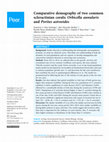
PeerJ, Oct 27, 2017
Background: Studies directed at understanding the demography and population dynamics of corals ar... more Background: Studies directed at understanding the demography and population dynamics of corals are relatively scarce. This limits our understanding of both the dynamics of coral populations and our capacity to develop management and conservation initiatives directed at conserving such ecosystems. Methods: From 2012 to 2014, we collected data on the growth, survival, and recruitment rates of two common Caribbean coral species, the stress-tolerant Orbicella annularis and the weedy Porites astreoides. A set of size-based population matrix model was developed for two localities in Northeastern Puerto Rico and used to estimate population growth rates () and determine the life cycle transition(s) that contribute the most to spatiotemporal differences in s. The model was parameterized by following the fate of 100 colonies of each species at the two sites for two years. Results: Our data indicate that spatial variability in vital rates of both species was higher than temporal variability. During the first year, populations of O. annularis exhibited s below equilibrium at Carlos Rosario (0.817) and Palomino (0.694), followed by a considerable decline at both sites during the second year (0.700 and 0.667). Populations of P. astreoides showed higher s than O. annularis during the first census period at Carlos Rosario (0.898) and Palomino (0.894) with a decline at one of the sites (0.681 and 0.893) during the second census period. Colony fate in both species exhibited a significant interaction with respect to location but not to time (G2 = 20.96; df = 3 for O. annularis and G2 = 9.55; df = 3 for P. astreoides). Discussion: The similar variability of s as well as the similar survival rates for both species during the two-year census period (2012-2014) show similar variability on demographic patterns in space and time. Our results suggest that location rather than time is important for the resiliency in coral colonies. Also, P. astreoides will show higher resistance to disturbance in the future than O. annularis.
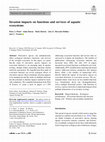
Hydrobiologia, 2020
Non-native species can simultaneously affect ecological structures, functions, and services of th... more Non-native species can simultaneously affect ecological structures, functions, and services of the invaded ecosystem. In this paper, we report that the study of non-native species impacts on ecosystem function is an emerging topic in aquatic ecology, though studies measuring functions remain relatively uncommon. We hypothesized that study of ecosystem function can reveal emergent effects of non-native species when community structure appears to be unimpacted and the study of multiple functions has the potential to identify impacts masked by foodweb complexity. We compiled information from Web of Science to create a pool of papers (n = 199) addressing ecosystem functions and services that we surveyed to evaluate our hypotheses. The number of publications referencing ecosystem function has increased since 2002, but only 10% of papers measured ecosystem functions as defined in our work. Additionally, 80% of publications reporting functional metrics addressed primary production and nutrient fluxes, while a low number of manuscripts (6%) directly linked the impact of non-native species on ecosystem functions to ecosystem services. We recommend future work focus on less-studied functions (e.g., bioturbation, decay rate, biomagnification), assess multiple functional metrics, link functions to services, and use networks to understand impacts from multiple dimensions of an invaders ecology.
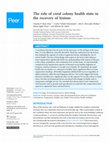
PeerJ, 2016
Coral disease literature has focused, for the most part, on the etiology of the more than 35 cora... more Coral disease literature has focused, for the most part, on the etiology of the more than 35 coral afflictions currently described. Much less understood are the factors that underpin the capacity of corals to regenerate lesions, including the role of colony health. This lack of knowledge with respect to the factors that influence tissue regeneration significantly limits our understanding of the impact of diseases at the colony, population, and community level. In this study, we experimentally compared tissue regeneration capacity of diseased versus healthy fragments ofGorgonia ventalinacolonies at 5 m and 12 m of depth. We found that the initial health state of colonies (i.e., diseased or healthy) had a significant effect on tissue regeneration (healing). All healthy fragments exhibited full recovery regardless of depth treatment, while diseased fragments did not. Our results suggest that being diseased or healthy has a significant effect on the capacity of a sea fan colony to repai...

Conservation Evidence Journal
The threatened staghorn coral Acropora cervicornis is an important reef-builder species in the Ca... more The threatened staghorn coral Acropora cervicornis is an important reef-builder species in the Caribbean. Its ecological importance and critical status have prompted efforts to restore degraded populations. In this respect, nursery-based programmes have effectively propagated A. cervicornis and helped to increase population sizes. Despite many advances in low-cost coral nursery designs, there is still a need to increase productivity while reducing costs. This study evaluates A. cervicornis demographic performance in two propagation structures: floating trees (FT) and floating horizontal frames (HF). Two equal-sized fragments were collected from 50 healthy staghorn coral colonies. Each fragment was placed into an FT or HF design. Survival, growth, branching, and productivity were recorded for seven months. To address the cost-effectiveness of the coral propagation techniques, we compared the total cost of producing corals between the two designs. Survival was similar, with 91% and 92...
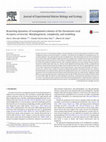
Journal of Experimental Marine Biology and Ecology, 2016
Acropora cervicornis is a threatened Caribbean coral that depends on branch fragmentation to prol... more Acropora cervicornis is a threatened Caribbean coral that depends on branch fragmentation to proliferate. Understanding the patterns of branch formation is, therefore, essential for the development of management and conservation initiatives. This study describes branch morphogenesis in 100 colony fragments that were transplanted to two reefs in Puerto Rico that differ in light intensity. Four morphometric variables were measured for one year: internode length, branch growth rate, the number of ramifying branches (mother branches; MB), and the number of branches produced (daughter branches; DB). Branching complexity was also evaluated using two indices: the Horton-Strahler bifurcation ratio (R b) and the Carrillo-Mendoza branching index (CM-BI). A simple discrete model was constructed to estimate the number of harvestable branches over time. No spatial difference was observed when comparing the development of the primary branches, as the mean internode lengths, the mean extension rates, and the mean number of branches produced did not differ statistically between sites. Likewise, internode lengths in secondary branches did not vary significantly between sites. In contrast, the mean branching and growth rates of secondary branches differed statistically between the two study locations. Significant spatial differences were also observed when comparing the total number of MB and the total number of DB but not for the ratio of DB to MB. The CM-BI was more appropriate than the R b in describing the branching structure of A. cervicornis. The model provided a good fit to the observed branching dynamics; demonstrating its usefulness as a tool for predicting branch productivity of this species. The implications for restoration activities are discussed.

Estuarine, Coastal and Shelf Science, 2015
Abstract Densities of the long-spined sea urchin Diadema antillarum remain significantly below pr... more Abstract Densities of the long-spined sea urchin Diadema antillarum remain significantly below pre mass-mortality levels at most Caribbean localities. The arrested recovery of this formerly abundant herbivore has been attributed to low supply of recruits and high post settlement mortality. There is, however, some debate as to which of these factors is determinant of the local dynamics of this echinoid. In this study, we use demographic modeling to analyze the contribution of recruitment and post settlement survival on the dynamics of D. antillarum in four localities of Puerto Rico Archipelago. Our results indicate relatively high adult survival, and low stasis but high growth transition in the small individuals. Recruitment rates were low and exhibited high spatial and temporal variability. The four populations exhibited asymptotic growth rates (λ) below 1.0, with λ varying from 0.918 to 0.964. The elasticity analysis showed that the survival of large-sized Diadema can potentially contribute most to the changes in λ for all sites. Numerical projections of the populations indicate that no site would exhibit an increase in density under current recruitment rates, but doubling recruitment would produce an increase in sea urchin density in three of the four sites. Recovery of D. antillarum populations would require the spatial and temporal co-occurrence of high recruitment and survival rates.
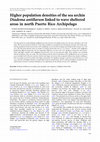
Journal of the Marine Biological Association of the United Kingdom, 2014
The long-spined sea urchin Diadema antillarum has been the focus of multiple studies since the ma... more The long-spined sea urchin Diadema antillarum has been the focus of multiple studies since the mass mortality event in the 1980s. The recovery of this key herbivore in the wider Caribbean is essential for the well-being of coral reefs. This study examined the population density and structure of D. antillarum at seven northern fringing reefs of Puerto Rico between 2011 and 2013. The total mean density of the sea urchins in northern Puerto Rico was 0.9 ±0.3 ind m−2. Densities of D. antillarum significantly differed among sites, but not temporally. Differences in mean sizes were significant among sites and seasons. Areas with higher densities of D. antillarum showed lower cover of non-calcareous algae. Wave exposure was correlated with the abundance of the sea urchin. This study indicates that the observed abundance of D. antillarum has not yet returned to pre-mortality levels. However, densities showed some degree of recovery when compared with previous studies, enabling at least some...
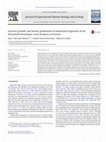
Journal of Experimental Marine Biology and Ecology, 2014
Fragmentation has been regarded as the most important reproductive strategy in the threatened ree... more Fragmentation has been regarded as the most important reproductive strategy in the threatened reef building coral Acropora cervicornis. Before the Caribbean-wide collapse experienced by A. cervicornis, asexual reproduction may have served as an effective source of new colonies to sustain and/or enhance local population growth. However, baseline information on the demographic success of fragments in nature is limited, hampering our ability to estimate the real contribution of asexual fragmentation to current population growth. In this study, natural occurring fragments of A. cervicornis were monitored for 18 months at two sites in Puerto Rico in order to quantify their survival, growth, and branching dynamics. Fragment survivorship did not exceed 26%, growth rates were relatively low with mean values ranging between 0.0242 ± 0.0168 (SE) and 0.0906 ± 0.0301 (SE) cm d −1 , and fragments barely produced new branches. No significant differences were found when comparing these demographic traits for different size categories. The relative low rates of survival, growth and branch production of natural fragments suggest that asexual fragmentation may not currently be a significant source of recruits for populations of this threatened coral.
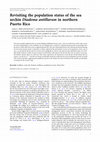
Journal of the Marine Biological Association of the United Kingdom, 2014
The mass mortality suffered by the sea urchinDiadema antillarumbetween 1983–1984 is considered on... more The mass mortality suffered by the sea urchinDiadema antillarumbetween 1983–1984 is considered one of the major causes of coral reef degradation in the Caribbean. Its near disappearance resulted in a disproportionate growth of macroalgae that has led to a ‘phase shift’ from coral-to-algal dominated reefs. The close relationship between this echinoid and the functioning of coral reef ecosystems makes it imperative to better understand the potential for recovery of its populations. From 2009 to 2011, we assessed the density and size structure ofD. antillarumin various reefs where previous population data were available. Results indicate a modest increase in density in all localities with respect to the last time they were surveyed in 2003/2004. Nevertheless, density values are still lower than values reported for the island prior to the die-off. Overall density did not surpass 1.49 ind. per m−2, and did not change considerably during the studied period. Lack of population growth coinc...
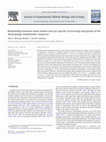
Journal of Experimental Marine Biology and Ecology, 2009
We examined the relationships between water motion and the distribution, abundance, and sizes (he... more We examined the relationships between water motion and the distribution, abundance, and sizes (heights) of Amphimedon compressa, an abundant sponge in reefs of La Parguera, Puerto Rico. Amphimedon populations were surveyed at different depths (3, 5, 8 and 12 m) in 3 inner-shelf and 3 mid-shelf reefs, which are protected and fully exposed to wave action respectively. More detailed studies on sponge survival and growth were performed at Las Pelotas (LP), a low wave energy site, and Media Luna West (MLW), a fully exposed reef. The effects of Tropical Storm Dean on sponge survivorship were also evaluated at these reefs. With the exception of an inner-shelf site, Amphimedon was absent in the 3 m depth zone in all reefs. Otherwise, no consistent depth-related patterns in abundances were detected among reefs. Sponges' heights generally increased with depth with the tallest sponges occurring in the 12 m zone. Survivorships at LP before Dean were not size-specific with semiannual rates averaging 86.3%. Survivorships at MLW before Dean were size-specific with the lowest semiannual rates (69.4%) for large sponges (N 20 cm) and the highest (94.5%) for small sponges (b10 cm). Tropical Storm Dean reduced survivorships to 41% and 30% at LP and MLW, respectively. At both sites, small and large sponges suffered significantly more losses compared to the mid-size sponges. Sponge growth rates were significantly higher at LP (4.5 cm yr − 1) compared to MLW (1.5 cm yr − 1). Growth rates were not size dependent at MLW while larger sponges grew faster at LP. The results of this study suggest that water motion may be an important factor controlling and structuring populations of A. compressa.
Journal of Experimental Marine Biology and Ecology, 2011
... Sponges also play an important role in the community structure of benthic habitats throughout... more ... Sponges also play an important role in the community structure of benthic habitats throughout inter and intra-specific mechanisms such as competition ([Aerts and van Soest, 1997] and [López-Victoria et al., 2006]) and mutualism ([Carballo and Ávila, 2004], [Goreau and ...

Revista de Biología Tropical
Introduction: The fireworm Hermodice carunculata is a widespread polychaete that can prey upon ma... more Introduction: The fireworm Hermodice carunculata is a widespread polychaete that can prey upon many coral species. However, few studies have examined the effect of fireworm predation on coral demographics during non-outbreak periods. Objective: To determine whether predation by H. carunculata compromised the growth, survival, and population performance of the threatened coral Acropora cervicornis. Methods: Nursery-reared coral fragments (n = 99) were fixed to the bottom of Punta Melones reef in the Island Municipality of Culebra, Puerto Rico. Predation activity and its demographic consequences on coral outplants were assessed from December 2020 to August 2022. Susceptibility to predation was compared between colonies collected directly from the reef and those originating from outside sources (e.g., coral nurseries). With the demographic data, simple size-based population matrix models were developed to 1) examine whether fireworm predation led to a significant decline in populatio...

Coral Reefs, 2015
Abstract Populations of Acropora cervicornis have collapsed throughout the Caribbean. This situat... more Abstract Populations of Acropora cervicornis have collapsed throughout the Caribbean. This situation has prompted the initiation of many restoration efforts; yet, there are insufficient demographic data and analyses to effectively guide these initiatives. In this study we assessed the spatiotemporal variability of A. cervicornis vital rates. We also developed a population matrix model to (1) evaluate the risk of population extinction, (2) estimate population growth rates (λ) considering different rates of colony fragmentation and fragment survival, (3) determine the demographic transition(s) that contribute the most to spatiotemporal differences in λs, and (4) analyze the effectiveness of outplanting coral fragments of different sizes. The model was parameterized by following the fate of 300 colonies from 2011 to 2013 at two localities in Puerto Rico. Demographic transitions varied spatiotemporally, with a significant interaction between location and time period on colony fate. Spatiotemporal variations in λ were also observed. During the first year, populations exhibited λs below equilibrium (0.918 and 0.948), followed by a dramatic decline at both sites (0.535 and 0.709) during the second year. The lower λs were caused by a decrease in the probability of stasis of large-sized colonies coupled with lack of sexual recruits and a meager contribution of asexual recruitment. Spatial variations in λs were largely due to differences in the probability of medium-sized colonies advancing to the largest size class. The viability analysis forecasts that the populations will reach quasi-extinction levels of 25 % of the initial population size in ≤16 yrs. Numerical simulations indicate that outplanting fragments ≥250 cm in total linear length (TLL) would result in a higher asymptotic population size than outplanting smaller fragments. We argue, however, that transplanting colonies ≤100 cm TLL will be a better management strategy because they can be produced faster and in higher numbers at coral nurseries.

Corals in a Changing World, 2018
Low-tech coral farming and reef rehabilitation have become important communitybased coral reef ma... more Low-tech coral farming and reef rehabilitation have become important communitybased coral reef management tools. At least in the wider Caribbean region, these strategies have been successfully implemented to recover depleted populations of staghorn (Acropora cervicornis) and elkhorn coral (A. palmata). They have also been used with relative success to recover depleted fish assemblages. Indirectly, coral reef rehabilitation has also resulted in enhanced benthic spatial heterogeneity, in providing multiple new microhabitats for fish and invertebrate species; have contributed to the recovery of coastal resilience, increasing the protection of shorelines against erosion; and have fostered an increased interest of the tourism sector as an enhanced attraction for visitors and recreationists. Nevertheless, there is still a need to implement best management practices to improve the success of these strategies. In this chapter, lessons learned from the Community-Based Coral Aquaculture and Reef Rehabilitation Program in Culebra Island, Puerto Rico, are shared from a multidisciplinary standpoint. Learning from past experiences is a critical process to improve science. In a time of significant projected climate change impacts and sea level rise, improving the scale of coral farming and reef rehabilitation has become a critical tool for coral reef conservation. But multiple roadblocks must still be overcome.
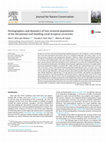
Journal for Nature Conservation, 2015
Acropora cervicornis is one of the principal reef-building organisms in the Caribbean; it is also... more Acropora cervicornis is one of the principal reef-building organisms in the Caribbean; it is also considered one of the most threatened coral species. Due to its ecological importance and critical status it is the focus of many restoration and management initiatives. However, studies that quantitatively measure the efficacy or feasibility of these efforts are mostly lacking. In this study, nursery-reared fragments of A. cervicornis were transplanted to two reefs in Puerto Rico as part of a reef rehabilitation program, and their survival, growth, and branch production were measured for a year. We also evaluated the effect of this restoration on the dynamics and viability of the fragment populations by means of a simple model. Survival of outplanted fragments surpassed 60%. Colony growth rate varied between 0.20 ± 0.18 and 0.29 ± 0.21 cm d −1 (mean ± SD) whereas branch production ranged between 7.02 ± 5.72 and 11.86 ± 7.06 (mean ± SD) branches per fragment per year. Survival did not vary considerably with respect to fragment size. In contrast, large fragments (≥25 cm) grew faster and tended to produce more branches than smaller ones. Model simulations indicate that (1) in the absence of recruitment, and without any subsequent human intervention, restored populations will decrease below a quasi-extinction level of 25% of the initial population size after just 3 years and (2) transplanting at least 20 colony fragments per year (12% of initial population) is sufficient to keep the restored populations above the 25% threshold. We conclude that A. cervicornis may be a feasible species for restoration projects given sustained human intervention and that transplanting fragments of at least 25 cm to reefs is an effective restoration protocol that requires minimum effort to maintain a viable restored population of this key reef-building coral.
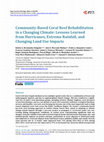
Open Journal of Ecology, 2014
Coral reefs have largely declined across multiple spatial scales due to a combination of local-sc... more Coral reefs have largely declined across multiple spatial scales due to a combination of local-scale anthropogenic impacts, and due to regional-global climate change. This has resulted in a significant loss of entire coral functional groups, including western Atlantic Staghorn coral (Acropora cervicornis) biotopes, and in a net decline of coral reef ecosystem resilience, ecological functions, services and benefits. Low-tech coral farming has become one of the most important tools to help restore depleted coral reefs across the Wider Caribbean Region. We tested a community-based, low-tech coral farming approach in Culebra Island, Puerto Rico, aimed at adapting to climate change-related impacts through a two-year project to propagate A. cervicornis under two contrasting fishing management conditions, in coastal areas experimenting significant land use changes. Extreme rainfall events and recurrent tropical storms and hurricanes had major site-and method-specific impacts on project outcome, particularly in areas adjacent to deforested lands and subjected to recurrent impacts from land-based source pollution (LBSP) and runoff. Overall, coral survival rate in "A frame" units improved from 73% during 2011-2012 to 81% during 2012-2013. Coral survival rate improved to 97% in horizontal line nurseries (HLN) incorporated

Marine Biology Research, 2018
In this study, the demography of the common demosponge Ircinia felix was examined at Tamarindo, a... more In this study, the demography of the common demosponge Ircinia felix was examined at Tamarindo, a coral reef located in the island municipality of Culebra, Puerto Rico. A preliminary study comparing the size structure of two subpopulations within the reef, Tamarindo Norte (TN) and Tamarindo Sur (TS), indicated that sponges at TN are significantly larger than sponges at TS. This result served as a baseline for the present comparative study in which we aimed to determine whether the spatial differences in population size structure can be explained either by a difference in rates of survival, growth, or recruitment, or a combination of these. To accomplish our goal, we followed the growth, survival and recruitment of I. felix at the two localities for one year. Growth was the only demographic parameter that differed significantly between localities. Because the most obvious distinction between the study sites was the absence of the octocoral Gorgonia ventalina at TS, we hypothesized th...
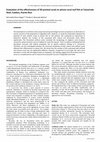
The development of artificial corals using 3D-printing technology has been proposed as an alterna... more The development of artificial corals using 3D-printing technology has been proposed as an alternative to aid the recovery of fish populations in degraded reefs. However, no study has empirically evaluated the potential of such artificial corals to attract fish to reef patches. We conducted an experiment to determine whether the number of fish associated with natural and 3D-printed corals differs significantly. The 3D-printed artificial corals mimicked the morphology of staghorn coral Acropora cervicornis, whose branches serve as habitat for many fish species. There is evidence indicating that fish abundance increases with habitat complexity, but no specific evidence relating to A. cervicornis. Therefore, we also investigated whether the structural complexity of both natural and artificial corals affected their effectiveness to attract fish. We found that the number of fish associated with artificial and natural corals was not significantly different. However, irrespective of coral t...
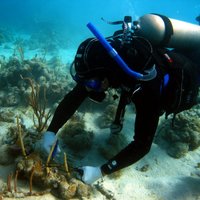








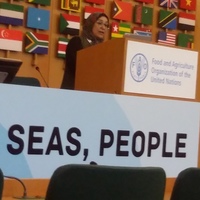
Uploads
Papers by Alex E. Mercado-Molina
managing non-linear dynamics, thresholds, environmental and climate uncertainty, and ecological surprises. In this context, coral demographic modelling becomes fundamental to address, not only ecological, but also sociological concerns. Only through sustained support and input of harvested corals restored populations, and by increasing the spatial scale of reef rehabilitation, restored populations can remain viable and grow under present and projected environmental and climate conditions. Understanding sociological dynamics, learning from others experiences, integrating visioning and scenario building, leadership building, multi-sectorial agents and actor groups, and strengthening cross-sectorial social networking are necessary adaptive approaches to cope with future environmental and climate changes, and are an integral part of reef rehabilitation. The combined benefits to social-ecological systems are multiple.With proper planning, design, funding, local support, and implementation, these can have long-lasting impacts in restoring coastal resilience.